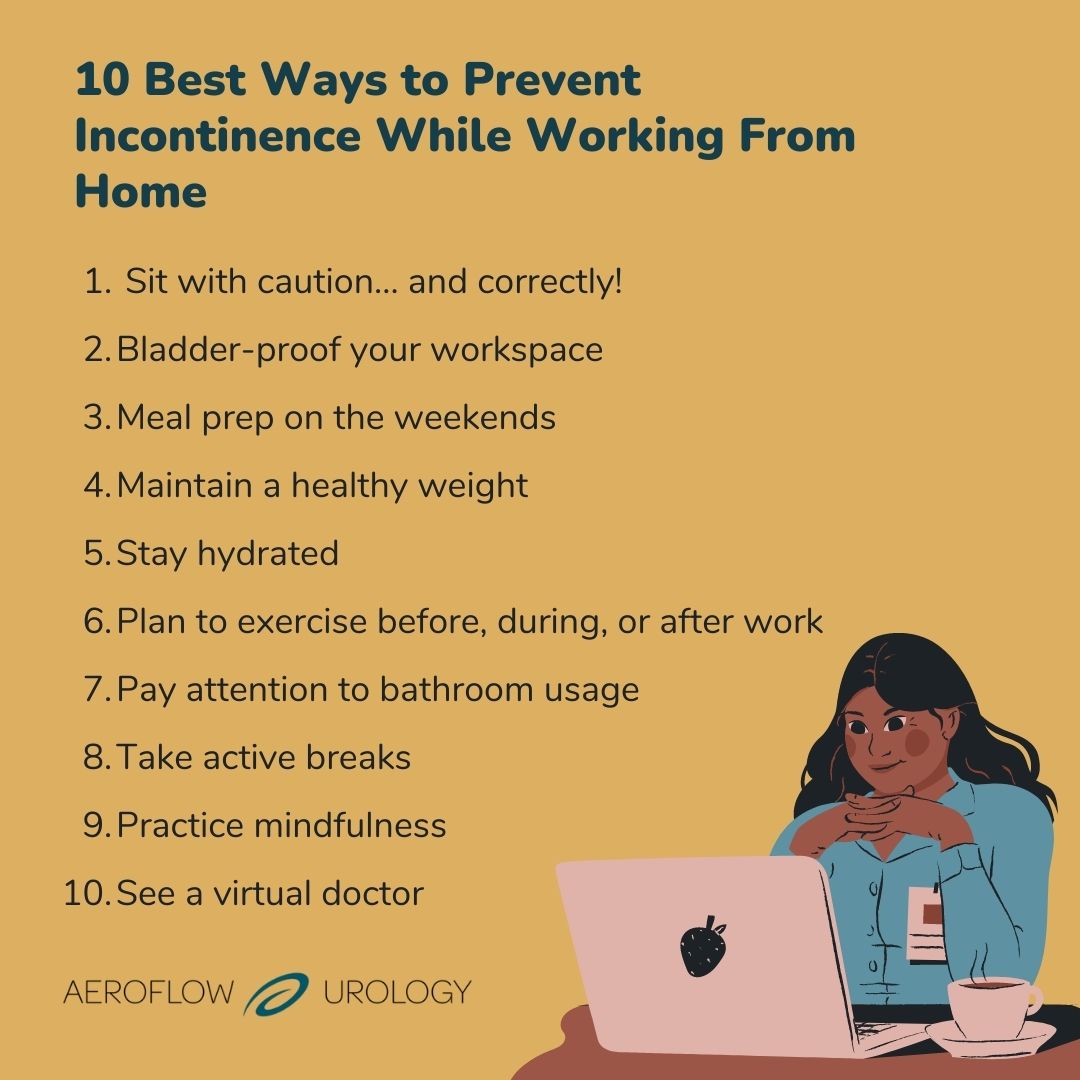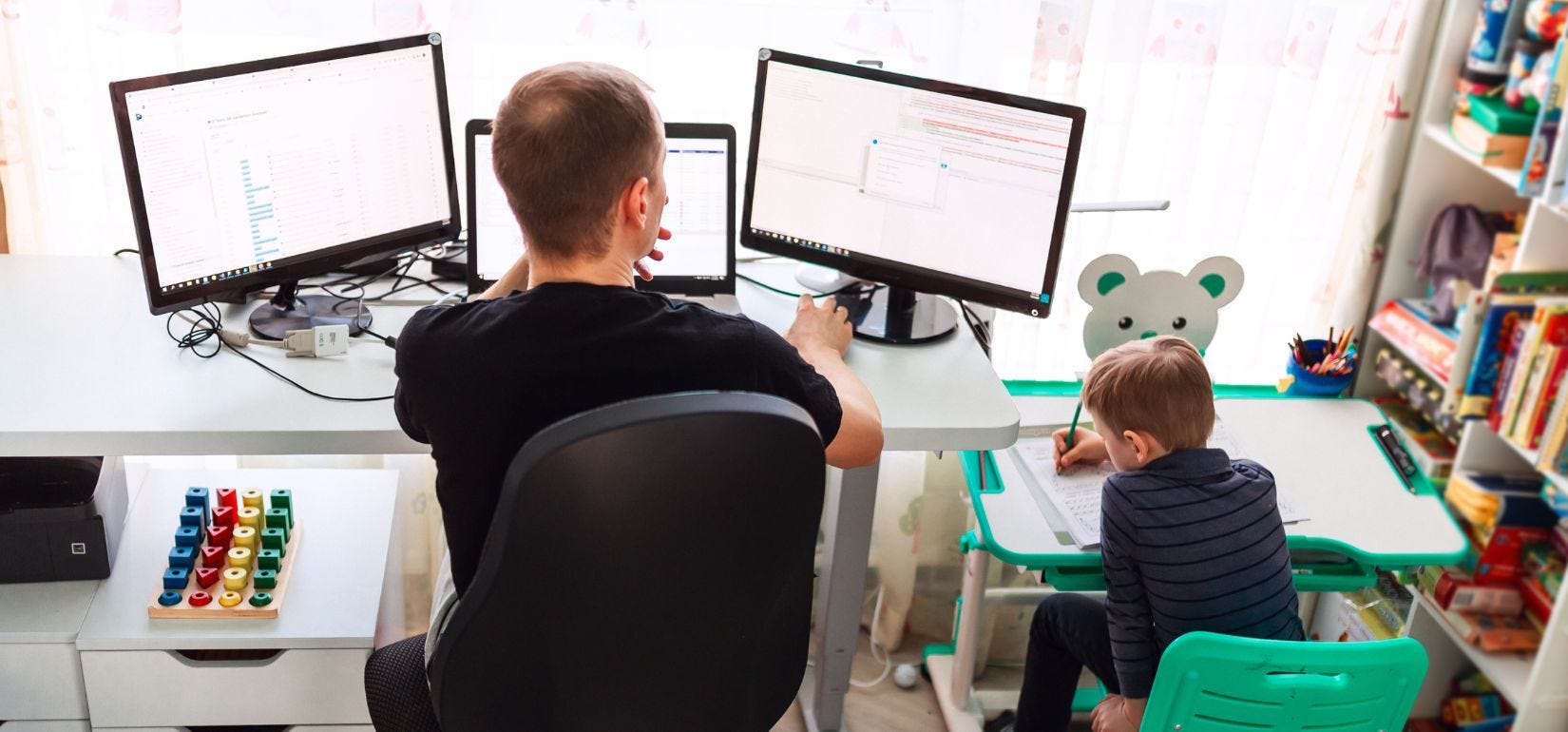Entering the remote work environment is an exciting time; You get to sleep in longer, use fewer sick days, pair blazers with sweat pants, and save on gas money. But living as a remote employee can also change your life for the worse by negatively impacting your physical health-- more specifically, the health of your bladder.
A recent survey published by Aeroflow Urology polled over 2,000 people working from home and found that almost half of people have experienced symptoms of urinary incontinence since the start of COVID-19.
With experts predicting that remote work is here to stay, those who work from home must find a way to prevent incontinence from developing.
In this post, we’ll tell you how to keep your bladder and pelvic floor healthy while working remotely so you can avoid incontinence.
What Is Urinary Incontinence?
Urinary incontinence is what happens when you lose control of your bladder. Common symptoms of incontinence include:
- Feeling the urge to urinate often, suddenly, or both.
- Nocturia, or waking up in the night to pee.
- Voiding your bladder more than 8 times in 24 hours.
- Leaking or dribbling urine.
There are a few different types of incontinence that people have reported experiencing during the pandemic while working remotely:
Check Your Eligibility
2 Easy Steps
Discover the continence care essentials available through your Medicaid plan.
- Overactive bladder (OAB): Urinating more frequently than average or feeling the sudden and strong urge to pee (also known as urge incontinence).
- Stress incontinence: Leaking urine when coughing, laughing, sneezing, or engaging in physical activities.
- Mixed incontinence: Experiencing one or more types of incontinence symptoms.
The Pandemic's Effect on Incontinence
Over one-third of workers in the United States reported that they began working from home during the COVID-19 pandemic, and it’s been proven that this new environment has negatively affected overall physical health and the functionality of people’s urinary systems.
Aeroflow Urology recently published a study that surveyed 2,501 people working remotely during the coronavirus pandemic. The survey found that:
- 25% of respondents said they’ve altered their schedules to cater to frequent urination.
- 43% reported experiencing an increase in an urge to void their bladder in the last year and increased urinary freq
- 14% said they urinate more than 7 times in 24 hours.
- 74% reported sitting for more extended periods since the pandemic's start.
- 40% of respondents said they sit for over 7 hours per day.
- 41% said they exercise less compared to before the pandemic.
- 43% reported decreased physical activity and an increase in urinary frequency.
These results, along with healthcare experts’ studies and opinions, have shown that the remote work environment can severely impact your bladder health and increase the chances of developing incontinence.
What Causes Urinary Incontinence at Home?
Incontinence while working from home can be attributed to a handful of factors.
- Sitting for too long. Sitting in chairs for long periods puts downward pressure on your pelvic floor, which is the group of muscles that cradles parts of your urinary system, such as the urethra and bladder, and helps control your ability to empty and hold your urine correctly. The pressure weakens these muscles and can lead to incontinence.
- Generally moving less. While working from home, you no longer need to commute to and from an office. You also probably move around less (getting up to speak with people, using a printer, etc.), and you most likely work longer hours. This decrease in movement can lead to less exercise for your body and pelvic floor muscles.
- Gaining weight. One study found that 41% of people working from home during the pandemic experienced weight gain. Extra weight adds extra pressure to your pelvic floor muscles, damaging them. It can also put pressure on your bladder, making you feel like you need to urinate more frequently.
- Worsening mental health. Stress, anxiety, insomnia, and depression–all of which have been linked to incontinence– have been reported by those who have worked from home during COVID-19.


- Getting less exercise. Exercise, including pelvic floor exercise, can help improve incontinence symptoms and strengthen your pelvic muscles. People who worked remotely during the pandemic have reported an overall decrease in exercise, increasing their chances of problematic urinary symptoms.
- Engaging in poor eating habits. One study found that 44% of remote workers ate more during the pandemic than before the lockdowns began. Research has also shown that during COVID-19 lockdowns, people ate unhealthy foods, such as sweets and junk food. Unhealthy foods can irritate your bladder lining and make you feel the urge to urinate more often than normal. Junk foods can also lead to weight gain, weakening pelvic floor muscles by placing extra pressure on them.
How to Prevent Incontinence While Working Remotely
Experts predict that the remote working trend will not only stick around but also increase in popularity in the upcoming years. This means that incontinence will significantly impact public health, with more and more people working from home developing incontinence.
If you fall into this category (even if you only work from home a few days out of the week), you should use the following tips to avoid incontinence symptoms and keep your urinary system healthy while working from home.
1. Sit With Caution... and Correctly!
Be mindful of how long you sit while working since this is one of the main ways you might be damaging your pelvic floor muscles. We recommend standing for 10 minutes every 45 minutes while working. It’s helpful to set a repeating timer on your phone or work computer to remind yourself when it’s time to stand. You can inform your boss or coworkers that you’ll be taking small, incremental breaks for your physical health if you need to walk around your home, or you can simply stand while continuing to work.
While sitting down for the recommended 45 minutes, be sure you’re sitting with good posture, which is crucial to reducing downward pressure on your pelvic floor. To sit with correct posture, try:
- Sit up straight— don’t slouch.
- Make sure your upper butt is touching the back of the chair.
- Put your shoulders back and align them with your hips, distributing your body weight evenly.
- Don’t arch your back.
- Stack your ankles and knees over each other and keep your knees slightly lower than your hips.
- Don’t cross your legs.
- Keep your feet flat on the floor.

Change your posture every half hour or so while seated, and adjust your chair so that you’re close enough to your computer to where you don’t need to slouch or arch to reach it. The perfect chair height allows you to keep your feet flat on the floor and your knees slightly below the height of your hips.
2. Bladder-Proof Your Workspace
We’ve all seen how to baby-proof rooms, so why not try bladder-proofing? Turn your home office (or work area if you don’t have a dedicated office) into a space that will support a healthy bladder and pelvic floor. Try these workspace solutions in your office to take the pressure off your bladder and get some movement throughout your day.
- Use an adjustable desk. These types of desks can quickly go from a low to a standing height with a bit of adjusting. You can find these desks at any price to fit your budget, or you can temporarily stack boxes or other hard surfaces on top of your desk to raise your computer screen or laptop while you stand.
Recommended: UPLIFT Desk.
- Sit on a better chair. Rather than using a kitchen, office, or living room chair, sit on an ergonomic chair or exercise ball.


Ergonomic chairs are designed to encourage correct posture so you won’t be struggling to get adjusted as often as you would in a standard office chair. They’re also made to have more seat depth, adjustable armrests, and lumbar support. You can opt for a stability ball for more movement and less restriction. Stability balls can also strengthen your core and align your spine.
Recommended: Gaiam Classic Balance Ball Chair, Branch Ergonomic Chair.
- Walk while you work. Yes, there are now treadmills that can fit under your desk! These treadmills can easily slide under your work area so you can get some steps in while staying stationary. Some are even made with collapsable handrails so that you can use them as regular treadmills outside work hours.
Recommended: Egofit Walker Smallest Under Desk Electric Walking Treadmill for Home.
- Put things far away. If you’re working from home, start telling yourself there’s no such thing as “too far away.” By placing necessary gadgets outside your immediate work area, you’ll have to get out of your chair to use them. While it doesn’t seem like a great effort, getting up to retrieve these items can add up throughout the day and help you move more than if everything was within arm‘s reach.
- Decorate with reminders or inspiring images. This may sound slightly silly, but putting a sticky note somewhere you often look, like next to your monitor, may remind you to get up and move. Digital sticky notes or reminders help, too. Your reminder can include your exercise schedule, how many standing breaks you should take, or even something as simple as “Sit up straight!“ Working inside all day can sometimes be depressing, so hanging inspiring images, such as someone jogging or a sunny scenic landscape, might encourage you to get outside throughout the day.
Recommended: Chrome Sticky Notes extension.
- Keep incontinence products on hand. If you do begin to experience incontinence symptoms while working from home, having high-quality products, such as protective underwear, underpads, or bladder pads nearby, may be helpful. Items like these are super absorbent and will keep you dry so you can work uninterrupted. To see if you qualify for free incontinence supplies with Aeroflow Urology, fill out our Eligibility Form.
3. Meal Prep on Weekends
Cooking from home at lunchtime is an excellent option for those who enjoy it because it requires you to stand up and move around. But, if you tend to have take-out delivered or resort to junk food, give meal prepping a try!
Preparing meals is beneficial to your bladder health because you can cook dishes that don’t irritate your bladder. Foods that do irritate it include:
- Spicy foods.
- Caffeine
- Soda
- Citrus fruits.
- Tomatoes
- Fried, processed, and greasy foods.
When your bladder lining is irritated after consuming these items, it can increase the urge to urinate and trips to the bathroom.
We recommend preparing your meals on Sunday so their shelf lives extend through the entire week and so you have set food options when Monday rolls around. Find recipes that incorporate foods that calm your bladder and are fibrous to avoid constipation (which can also cause incontinence symptoms). Bonus- if your lunch is already made, you’ll have more time to exercise or walk on your break if needed.


4. Maintain a Healthy Weight
Extra weight places more pressure on your bladder and pelvic floor muscles, making you urinate more frequently and weakening your pelvic floor. To maintain a healthy weight, you should first speak with your healthcare provider to find your ideal body mass index (BMI) and make a plan from there. If you’re attempting to lose excess weight, you must do so in a healthy and realistic manner, so incorporate daily exercise before, during (this is where the under-the-desk treadmill comes in handy), or after work. In addition, use your healthy, prepared meals to consume a nutritious diet throughout the week.
5. Stay Hydrated
Keep a reusable water bottle with you throughout the workday to stay hydrated, especially if you‘re exercising. Water helps flush out toxins, decreasing your risk of urinary tract infections (UTIs). It also helps prevent incontinence by keeping things flowing in your urinary system. And while it may sound counterintuitive, not drinking water to avoid trips to the bathroom while working actually makes you pee more. This is because concentrated pee- the kind of urine you have when dehydrated- irritates your bladder, causing that “have to go” urge. Studies show that dehydration can also make you tired and cause brain fog, which isn‘t a great combination when working from home.
Refill your water bottle throughout the day if it’s smaller; This can aid in weight loss and help you move around, taking pressure off your pelvic floor.
Recommended: SLUXKE 1 Gallon Water Bottle
6. Plan to Exercise Before, During, or After Work
Even when working remotely, fitting exercise into your schedule daily can be tricky, which is why it’s helpful to schedule exercise into your daily routine. If you’re a morning person, working out before clocking in can help give you a burst of energy. Night owls can make time to go to the gym or jog after work to clear their minds. Exercising during your lunch break is another option for those who are too busy before and after work.
We recommend a few different types of exercises (for both men and women) to do at home or the gym to keep your pelvic floor muscles functioning to the best of their ability:
- Pelvic floor exercises: Kegels are not just for females and older folks! These exercises can strengthen the pelvic floor of anyone of any age. Set a time during your day to do some Kegels to help prevent incontinence from developing. They don’t take much time and work other parts of your body as well, such as your core, legs, and glutes.
- Yoga: An excellent option for stretching out after a long day of work, yoga strengthens your body, helps with weight loss, and calms your mind.


- Swimming: Swimming is a full-body workout that also gets you out of the house after a day inside.
- Jogging or running: Running has many health benefits, from decreasing stress and anxiety to improving cardiovascular health. If you leak urine when you run, there are ways to manage your symptoms, so don’t let that stop you if you love this activity!
Avoid cycling on stationary bikes or biking outside for long periods, as bikes can damage your pelvic floor muscles.
You can also try out these exercises while seated at your desk:
- Tricep dips: Dip off your work chair until your butt almost touches the floor with both hands on the seat. Repeat.
- Desk push-ups: Use your desk as the surface you push off while standing and slowly lower yourself back down to the desk. Repeat.
- Seated knee-to-chest: While seated, bring your knees to your chest one at a time, changing legs as you go.
- Seated leg extensions: With a straight back, lift one leg until it’s parallel to your hip height and lower it back down. Alternate legs.
In order to stick to your exercise routine, reach out to coworkers. You can even create a virtual exercise-from-home group people can participate in so everyone keeps their bladders healthy!
7. Pay Attention to Bathroom Usage
Working from home can pose a threat when it comes to using the bathroom since it’s so convenient to get to. Urinating when your bladder isn‘t full can train it to send full signals to your brain even when you don‘t need to empty it, so pay attention to how often you’re going to the restroom to urinate. Voiding your bladder 6 to 8 times a day is considered normal, so try not to go more than that. If you do find that you need to pee more than 8 times throughout the day, you may have OAB, so consult a healthcare professional, such as a urologist or your provider.
When you do use the bathroom, make sure you give yourself enough time to empty your bladder completely; Leftover urine can cause UTIs and dribbling pee after urination.
8. Take Active Breaks
Even if you’re standing up every 45 minutes while working, it can still feel like you’ve been unable to move all day. Walking briskly for just 10 minutes has been shown to increase alertness and energy and improve your mood. Walking also aids in weight maintenance which can prevent incontinence, so set aside time for outdoor mini-breaks if possible. Use notes or set alarms to remind yourself of break times.
9. Practice Mindfulness
Just because you work from home doesn’t mean burnout isn’t real! Many people who have worked remotely during the COVID-19 pandemic reported feelings of isolation and anxiety due to burnout.


Mental health conditions like these have also been linked to incontinence. To combat these states, incorporate mindfulness into your daily work routine. It may be helpful to meditate or journal before work to start the day with a calm and clear mind. Or, if you are stressed out during the workday, try a guided meditation on a break.
10. See a Virtual Doctor
It’s essential to continue seeing a healthcare provider during the pandemic and while working remotely. Your clinician may be able to provide you with more tips to prevent incontinence as a remote worker, as well as provide you with a care plan if you do contract the sars-cov-2 infection. An easy way to see your healthcare provider during the pandemic is to set up virtual appointments online.
If You Already Have Incontinence Symptoms...
If you’re already experiencing incontinence while working remotely, you should use incontinence care products, maintain a healthy weight, exercise, and eat healthily to keep your symptoms from worsening.
Wearing incontinence products, such as bladder pads, protective underwear, and briefs, will help keep you dry and comfortable while sitting, standing, or exercising. These absorbent, odor-controlling, breathable products also prevent skin rashes and keep your clothes from getting wet with leakage, giving your more time to focus on work and maintain your quality of life.
If you need incontinence supplies but can’t get to the store to buy them due to contracting the coronavirus disease, or you simply don’t have the extra income to spend, you may want to look into receiving products through your insurance plan with Aeroflow Urology.
You may qualify for free incontinence supplies and you can get them shipped directly to your door for free every month. All you need to do is fill out our qualify form to find out if you’re eligible!
Xiao, Y., Becerik-Gerber, B., Lucas, G., & Roll, S. C. (2020). Impacts of Working From Home During COVID-19 Pandemic on Physical and Mental Well-Being of Office Workstation Users. Journal of Occupational & Environmental Medicine, 63(3), 181–190. NCBI. https://doi.org/10.1097/jom.0000000000002097
Bureau, U. C. (2021, March 31). Working From Home During the Pandemic. The United States Census Bureau. https://www.census.gov/library/stories/2021/03/working-from-home-during-the-pandemic.html
Ph.D, B. R. (n.d.). Remote Work Is Here To Stay And Will Increase Into 2023, Experts Say. Forbes. Retrieved June 28, 2022, from https://www.forbes.com/sites/bryanrobinson/2022/02/01/remote-work-is-here-to-stay-and-will-increase-into-2023-experts-say/?sh=2a4dcd1d20a6
Alah, M. A., Abdeen, S., Kehyayan, V., & Bougmiza, I. (2021). The Impact of Changes in Work Arrangements during COVID-19 Pandemic on the Lifestyle of Qatar’s Working Population. Journal of Occupational & Environmental Medicine, Publish Ahead of Print. https://doi.org/10.1097/jom.0000000000002443
https://www.frontiersin.org/articles/10.3389/fpubh.2022.774509/full#:~:text=During%20lockdown%20and%20remote%20work,the%20amount%20of%20food%20consumed.
Alamri, E. S. (2021). Effects of COVID-19 home confinement on eating behavior: A review. Journal of Public Health Research. https://doi.org/10.4081/jphr.2021.2088
How to Tell If You’re Dehydrated: Signs and Symptoms. (2021, December 7). Healthline. https://www.healthline.com/health/how-to-tell-if-youre-dehydrated#:~:text=Poor%20concentration%20and%20altered%20mental
Mental Health Foundation. (2016, January 18). How to look after your mental health using exercise. Mental Health Foundation. https://www.mentalhealth.org.uk/publications/how-to-using-exercise#:~:text=Physical%20activity%20has%20a%20huge
Combating burnout, isolation, and anxiety in the remote workplace. (n.d.). GitLab.https://about.gitlab.com/company/culture/all-remote/mental-health
Information provided on the Aeroflow Urology website is not intended as a substitute for medical advice or care from a healthcare professional. Aeroflow recommends consulting your healthcare provider if you are experiencing medical issues relating to incontinence.









